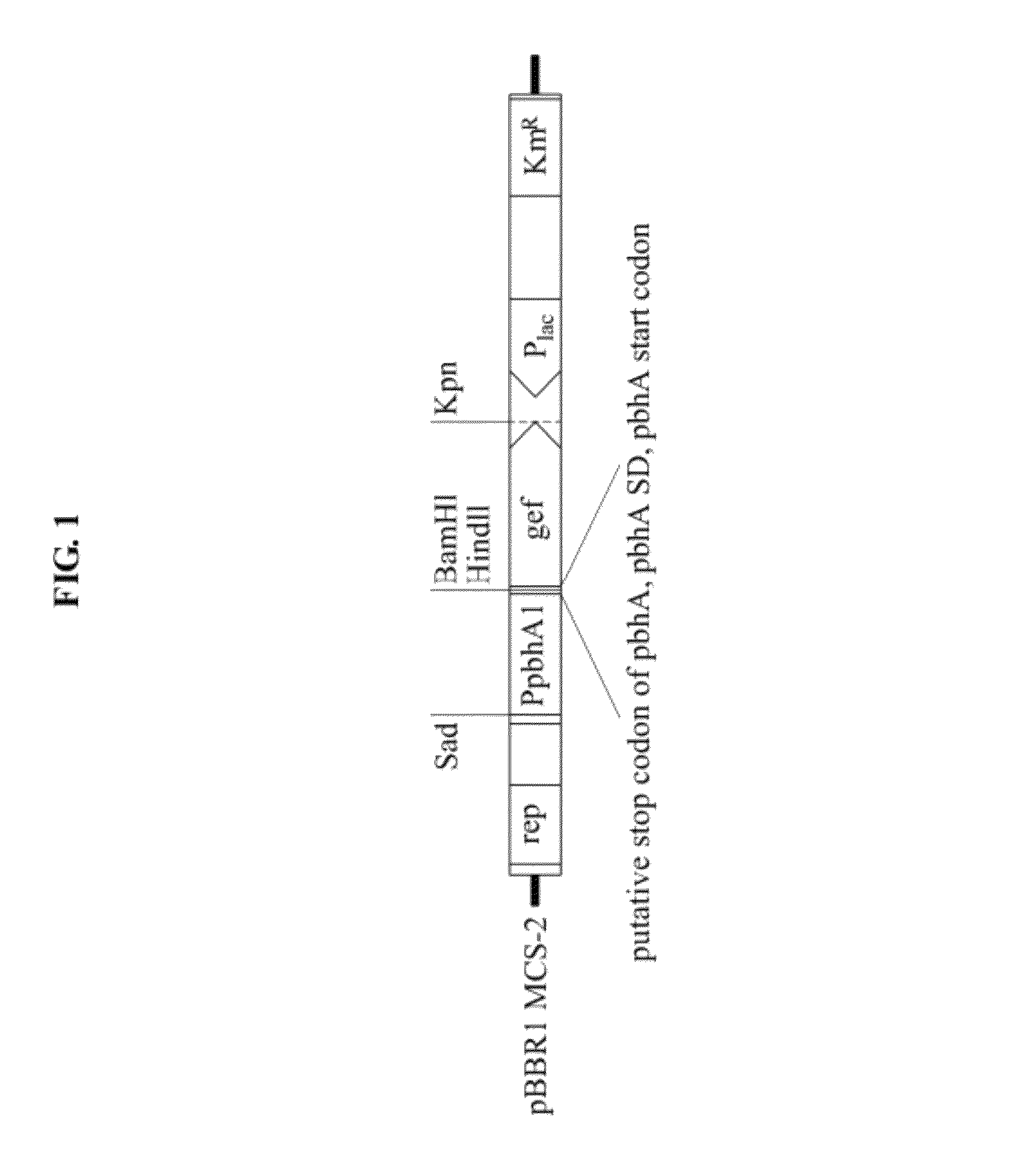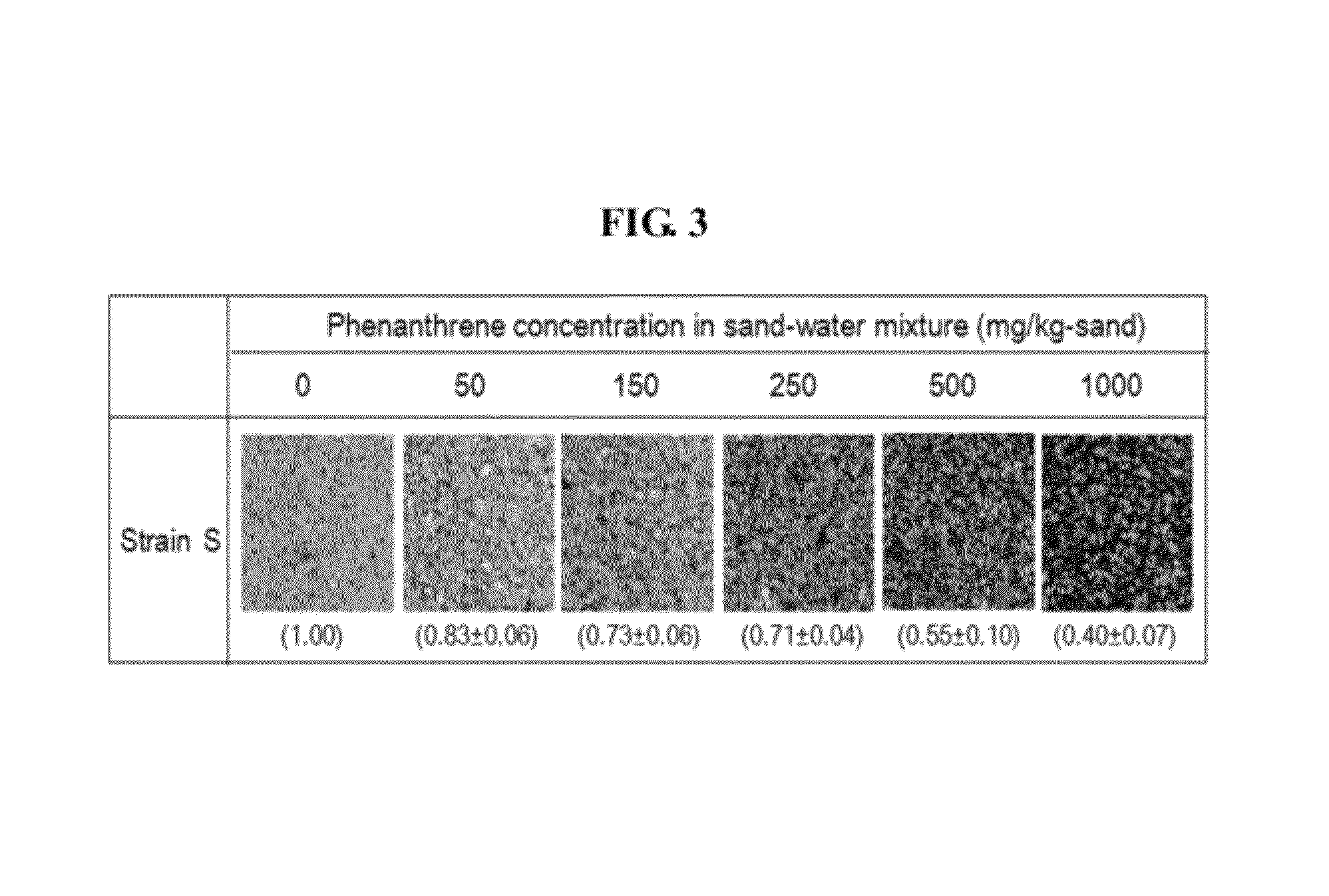Self-dying recombinant microorganism for measuring soil and water contamination
a technology of recombinant microorganisms and soils, which is applied in the direction of microorganisms, biochemistry apparatus and processes, bacteria based processes, etc., can solve the problems of not appropriately showing the bioavailability and toxicity of contaminant, and the scheme may not take into account the interaction between organisms existing in soil or water and the contaminant, so as to achieve the effect of reducing the amount of an aromatic hydrocarbon and measurable soil or water contamination
- Summary
- Abstract
- Description
- Claims
- Application Information
AI Technical Summary
Benefits of technology
Problems solved by technology
Method used
Image
Examples
example
Example 1
Construction of Recombinant Strain
[0029]A recombinant strain, Sphingomonas paucimobilis (SEQ ID NO. 1), was constructed using Sphingomonas paucimobilis EPA505 that is a microorganism degrading aromatic hydrocarbons.
[0030]pBBR1-MCS2 that is a broad-host range vector was used as a vector for construction of the recombinant strain. A recombinant plasmid was obtained by recombining a promoter site of pbhA gene that is expressed by aromatic hydrocarbons and gef gene that is a microorganism-killing gene, using pBBR1-MCS2. Sphingomonas paucimobilis SQL2 was constructed by inserting the recombinant plasmid to Sphingomonas paucimobilis EPA505.
[0031]FIG. 1 illustrates a structure of a recombinant gene fragment according to an embodiment of the present invention.
[0032]Referring to FIG. 1, PpbhA1 may denote a putative promoter region of pbhA gene, KmR may denote a kanamycin-resistance gene, gef may denote a microorganism-killing gene (gene expression fatal), and rep may denote an origi...
example 2
Verification of Substrate Specificity
[0034]Phenanthrene was added to an inorganic medium including pyruvate as a carbon source, up to phenanthrene concentrations of about 50 mg / L through about 500 mg / L, the recombinant strain was inoculated, and a sample was taken every 24-hour and stained using LIVE / DEAD BacLight bacterial viability kit (Molecular Probes, L7012) and a fluorescence reaction was measured by a micro-plate reader.
[0035]A reaction of the recombinant strain with respect to an inorganic medium including hexane and hexadecane that are aliphatic hydrocarbon having the equivalent concentration, hexane concentrations being about 50 mg / L through about 500 mg / L and hexadecane concentrations being about 50 mg / L through about 500 mg / L, and a reaction of the recombinant strain with respect to an inorganic medium including toluene that is a monoaromatic hydrocarbon, toluene concentrations being about 1 mg / L through about 50 mg / L, were respectively measured for comparison.
[0036]The ...
example 3
Verification of Performance of Recombinant Strain in Model Soil
[0041]Ottawa sand was used as a model soil. The model soil was contaminated with phenanthrene up to concentrations from 50 mg / kg to 1000 mg / kg, an inorganic medium including pyruvate as a source of carbon was added, the inorganic medium of 10 mL per the model soil of 2 g, the recombinant strain was inoculated, and a sample was taken every 24-hour to measure a fluorescence response.
[0042]A fluorescence response was photographed by a CLSM to directly measure a mixture of the model soil, the liquid medium, and the recombinant strain, and the measured fluorescence reaction was quantified using an ImageJ program. Table 1 compares characteristics of the model soil and characteristics of a real soil (M soil).
[0043]
TABLE 1OrganicHydrogenmatterFieldion con-Soilcontent inmoisturecentrationAreatexturesoil (%)capacity(pH)(m2 / g)aOttawa sandSand00.0507.00.13M soilSandy loam11.50.3586.82.4
[0044]FIG. 3 is a picture, photographed by a CL...
PUM
| Property | Measurement | Unit |
|---|---|---|
| concentrations | aaaaa | aaaaa |
| concentrations | aaaaa | aaaaa |
| concentrations | aaaaa | aaaaa |
Abstract
Description
Claims
Application Information
 Login to View More
Login to View More - R&D
- Intellectual Property
- Life Sciences
- Materials
- Tech Scout
- Unparalleled Data Quality
- Higher Quality Content
- 60% Fewer Hallucinations
Browse by: Latest US Patents, China's latest patents, Technical Efficacy Thesaurus, Application Domain, Technology Topic, Popular Technical Reports.
© 2025 PatSnap. All rights reserved.Legal|Privacy policy|Modern Slavery Act Transparency Statement|Sitemap|About US| Contact US: help@patsnap.com



